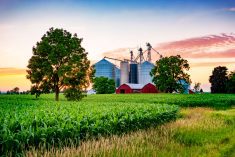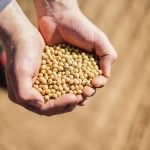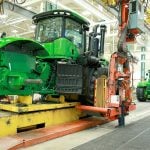Remember 2008? Farm commodity prices skyrocketed, and right on cue, machinery sales jumped too. The 2008 bump was so big, farmers bought equipment even faster than manufacturers could build it.
It was proof that commodity prices are all it takes to drive machinery sales. Or so it seemed.
Optimism was everywhere that year. All the major brands announced expensive plans to expand their assembly plants and to enhance their productivity to cope with the new demand. Many Canadian implement companies rode the wave too, and they were hard at work on their own expansions.
Read Also

The farm transition trial
For anyone affected by cancer, they have likely heard the adage that “a person doesn’t get cancer, the family does.”…
Just how significant was the jump in sales? According to data from the Association of Equipment Manufacturers (AEM), sales of four-wheel drive tractors in 2008 soared 54 per cent over the previous year, and they more than doubled the numbers of only two years prior. Combine sales leaped 34 per cent over 2007 numbers as well.
Because of the high commodity prices, farmers had spare cash in their pockets for the first time in years, and they were willing to spend that cash on equipment. Everyone said the same thing. Spokesmen for the different machinery brands all attributed the sales spike to pent-up demand after years of dismal crop markets.
Those same spokesmen also publicly stated that as far as company executives of all colours could see, the good times in farming — and therefore, the good times in the machinery industry — were here to stay, at least for the foreseeable future.
Then in 2009, farm gate prices slid, and while the optimism didn’t disappear altogether, it’s fair to say that it cooled.
But then the unexpected happened.
Despite the drop off in crop prices, machinery sales kept chugging ahead. Sales figures remained strong, at least for high-horsepower tractors. Combine sales actually jumped another 17 per cent.
Was it a fluke?
Now that 2010 is behind us and the sales numbers for the year are officially in, has the bubble finally burst?
The answer, in a word, is no.
The large-scale farmers that the industry has come to call “professional producers” are driving demand, with a focus on high-capacity equipment. That’s why four-wheel drive tractor sales jumped yet another 13 per cent last year, and the industry says it’s why the market for combines just won’t seem to let up, with Canada’s farmers buying 5.2 per cent more combines last year than in 2009.
In a backhanded way, it’s also why tractor sales in the utility segment (under 100 horsepower) have been soft for the past couple of years, although they did see marginal gains in 2010. These machines usually don’t figure prominently in a large farm’s fleet, which may explain why their sales numbers haven’t kept up.
So, why are producers, particularly the big ones, still buying? After all, you’d expect the pent-up demand that added fuel to the fire two years ago would have run out of steam by now.
The best explanation seems to be that there is a mix of factors responsible for the phenomenon.
The mandatory jump to Interim Tier 4 (IT4) engine emissions standards in January is one of the driving forces. Sales of tractors above 175 horsepower have been red hot as many producers picked up a new Tier 3 version before year end to avoid the looming price increases promised for 2011 — not to mention wanting to stay with engine designs they’re already familiar with.
While there was a shortage of hard and fast information last year about how large those price increases would actually be, there was ample speculation. Most of it put the figure somewhere near 10 per cent which, given the price of new equipment, is significant to say the least.
According to AEM’s data, December sales of rigid-frame tractors in that 175-plus horsepower range rose an impressive 41.5 per cent over the same month in 2009. And while that suggests IT4 certainly had an impact on motivating farmers to buy, overall it may not have been as influential as first thought.
It’s More Than IT4
“I think we might be overestimating the influence of Tier 4 on sales,” says Steve Koep, vice-president of North American sales for AGCO. “I never got the sense people were buying because of it.” So, what does he consider to be the driving forces behind the year’s relatively good sales numbers?
“I think we had kind of the perfect storm,” he replies. “Yields were good and farm commodity prices started to creep up.” In essence, it comes back to the same old story: if farmers have the cash to afford new equipment, they’ll buy it. But this year IT4 added a tailwind to the trend.
Executives at the other brands haven’t overlooked the impact of good old-fashioned high farm incomes on sales figures either, particularly when it comes to predicting the industry’s future.
“The combination of low grain reserves and higher global demand bodes well for crop prices over the long term,” writes Samuel Allen, John Deere’s chairman and CEO in that company’s 2010 annual report. “This, in turn, should help sustain our customers’ profitability and support further profitable growth for John Deere.”
Allen’s reference to higher global food demand seems to be a key factor in everyone’s outlook for the future, even — or perhaps especially — for the long term.
“My personal vision is (food) demand will be much stronger than supply for the next century,” said Martin Richenhagen, AGCO’s chairman, president and CEO, during an interview on the Fox News Network late last year. “When you think about the history of mankind, we had higher demand than supply for thousands of years. Only around the 1900s, when we started to mechanize, that changed. I think we are going back to where we have been in the past.”
As remarkable as it may be for a corporate executive to publicly predict 100 consecutive years of good farm profits, it’s part of a trend we’ve seen from the major manufacturers lately. They’re not only commenting in annual reports about the good times they see coming in order to buoy shareholders’ optimism, that message of clear sailing and blue skies ahead is starting to show up in corporate advertising.
Case IH’s “Will you be ready?” campaign is a prime example. Talking about a booming population and diminishing agricultural resources emphasizes the classic economic theory of supply and demand that armers are all too familiar with. But this time, farmers can’t help but view it in a positive way. What better news could there be for producers than limited supply and growing demand?
Banging the drum?
Banging the drum can’t help but create optimism among the farmers who buy new machines. It has the potential to be one of the most effective advertising themes to come down the pike in a very long time. Ironically, it almost ignores the equipment it intends to sell.
All this doesn’t mean the machinery industry is putting on blinders and is only willing to see bigger and better sales numbers in the future. Optimism may be rampant, but company executives certainly haven’t abandoned common sense and realism.
“If you look at 2011, I think it’s going to be another year that’s good for the farmer,” says Koep. “But we look for some industries to back off a little. (Sales of) 14,000 combines in North America, for example. We don’t think the industry can sustain that.”
CNH (the parent company of Case IH and New Holland), however, still sees some room for growth. “CNH anticipates that in 2011 the global agricultural markets will be flat to up five per cent in tractors and up five to 10 per cent in combines.”
There is one other thing all the companies do agree on. That is that continuing to grow their businesses means tapping the same market forces expected to keep farmers’ future incomes high, namely the ever-growing middle class in India and China. Getting a market foothold in emerging economies holds the key to success not only for farmers but for growth in the machinery sector as well.
Samuel Allen’s comment seems to sum up what all the companies are saying. “Partly as a result of these positive macroeconomic factors, extending the John Deere brand to a wider worldwide audience remains a top priority,” Deere’s chairman said.
All the major brands are moving quickly to set up shop in parts of the world that up until now held no promise for them.
Exactly how they are battling it out to create brand loyalty among those up-and-coming farmers who will soon own a tractor for the first time is a story in itself. Look for a discussion on that in a coming issue of Country Guide.CG
———
Who’s optimistic? Just ask Martin Richenhagen: “Demand will be much stronger than supply for the next century”















